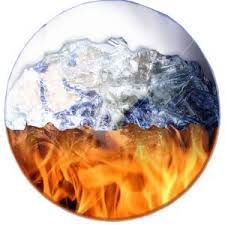
Global warming means arctic melting.
In the State of Wisconsin, USA, where much of my extended family still lives, winter temperatures have sunk as they did 50 years ago when I grew up there. A stretch of 20 degrees Fahrenheit below zero for a few weeks in January seemed normal. We have seen fewer stretches like that in recent decades, that is, until this winter, 2013-2014.
Pipes froze in the oldest of my family’s Wisconsin properties a few weeks ago, causing a small crisis team to descend upon La Crosse for an emergency plumbing party. Talk of global warming filled the conversations more often than usual as we replaced galvanized with pex, and those conversations persist even now in my mind.
So news in the past week of Arctic warming caught my attention. A large crisis now shakes the far north as melting ice and snow push ice flows out faster than ever before. How does my home state, Wisconsin, freeze while just a thousand miles north the pole smothers in relative heat?
One article caught my searching attention today that explains how Arctic air structures resemble a layered cake. Unlike the jungles in tropical parts, the north and south poles retain their heat with layers of different temperature and density air, and some of the layers invert by putting hotter layers above colder ones. In contrast, tropical hot air launches miles high during frequent rain storms, dissipating heat into space.
No one else appears to piece together cold Midwestern winters, hot tropics, and warming poles, but here’s my take on it nonetheless. As a pole warms, layers of heavy air press cold air away from the pole and out towards the mid latitudes including Midwestern America, Europe, and Russia. Perhaps the planet’s spin or magnetism compresses its polar layers. Those layers retain heat that melts polar ice and sends warmer water to the ocean. The tropics, on the other hand, warm with the extra energy in the oceans as well as more direct sun exposure.
Human influence on weather from fossil fuel burning, cement making, and jungle deforestation has produced and will likely produce future ocean warming. However, since the poles will not send warmth away to outer space, they will heat up faster than the rest of the world. Rising shore lines might create larger crises that attract the world’s collective attention in the coming decade. But what about today? What about contemporary policies on human influences on global weather? Despite my scientific skepticism over lack of long term data to assess those human influences, the last 25 years of political clamor on the topic consistently and with increasing supporting data suggest changes to human activities on a large scale should be a priority topic of conversation among us all.
Why don’t all building codes require priority attention to solar, wind, and similar renewable tech for new construction, for example? Why don’t car makers sell existing battery tech to offer more electric vehicles for emission control? Why aren’t we all taking control of what we can control to improve the environment of our world? What do you think?
http://www.livescience.com/43045-arctic-warming-linked-stratified-air.html
http://nsidc.org/cryosphere/arctic-meteorology/climate_change.html
http://en.wikipedia.org/wiki/Global_warming
http://www.weather.com/news/science/environment/arctic-blast-linked-global-warming-20140106
http://www.ncpa.org/pdfs/st321.pdf




 The 2014 Super Bowl in the US, nicknamed after various references to marijuana (mj) because the two competing teams come from the states of Washington and Colorado where mj recreational use is legal, has raised to a higher level than ever the national debate on mj legalization. For the US, a
The 2014 Super Bowl in the US, nicknamed after various references to marijuana (mj) because the two competing teams come from the states of Washington and Colorado where mj recreational use is legal, has raised to a higher level than ever the national debate on mj legalization. For the US, a